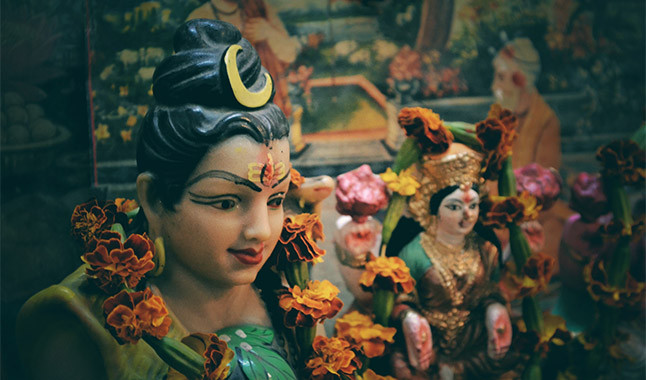
Shiva - The Cause Of All Causes
Shiva can be split as Sha+ee+va where
• Sha stands for shareeram or body
• Ee stands for eeshwara or life giving energy
• Va stands for vayu or motion
Thus Shiva represents the body with life and motion.
If the 'ee' is removed from Shiva, it gets reduced to sha+va or Shava which means a lifeless body. Anything with Shiva is with life, and anything without Shiva is Shava, or without life.
So Shiva is auspicious, Shiva is potential, and Shiva is life. Shiva is all encompassing - the universal soul or consciousness. Realizing this Shiva Tattva leads to Ananda (bliss).
Who is Shiva? What is Shiva Tattva?
Gurudev: I would ask the question 'What is not Shiva?' Is Shiva somebody? Is he a form? Is he someone sitting in some place? No! Shiva is the entire universe. He is in every atom of the universe.
The Shiva Tattva Has Three Stages:
- Arupa - without form
- Rupa-arupa - form emerging from the formless
- Sarupa - with form
Before creation, the process of creation and the creation, is Shiva.
Shiva doesn’t have a body, he was never a person at all. To symbolize the unfathomable, the infinite divinity, and to make it comprehensible for young people, for children and others, they made a form. In fact, there is no form to Shiva.
Shiva is a principle (Tattva) from where everything has come, everything is sustained in it, and everything dissolves into it. Shiva is the space, it is the consciousness.
There is no way that you can even step out of Shiva at anytime because Shiva is the summum bonum of the whole creation. That is why Shiva’s body is depicted in blue because blue signifies the sky; the all pervading infinity which has no limits, and no shape.
The consciousness which is bliss and innocence, the consciousness which is the bestower of dispassion - is Shiva. The whole world is moving in an auspicious rhythm of innocence and intelligence - that is Shiva.
The permanent and eternal source of energy, the eternal state of being, the one and only one - is Shiva.
The soul (of everything) is called Shiva – there is no difference between the soul and Shiva.
It is a miracle how the same consciousness is present in every being in this creation! There is no other miracle greater than this.
It Has No Form Yet It Is In All Forms
In the Rudra-abhishekam, it is said, 'Virupe-bhyo vishva-rupe bhyash-cha vo namo namah'.
Virupe-bhyo means, that one which has no form and, Vishva-rupe-bhyo means, yet it is in all the forms of the universe.
Everything, all forms are the manifestation of the formless Shiva. Shiva is the consciousness that present all over; it is an energy field.
It Never Began and It Will Never End
Shiva is never born and he has no end. He is eternal. He is the fourth state of consciousness, known as the 'Turiya avasta' (the meditative state), that is beyond the waking, sleeping and dreaming state.
There is a beautiful story related to Shiva. Once Brahma the creator, and Vishnu the preserver of the Universe wanted to find Shiva and understand it completely. So Brahma said, I will go and look for his head and you find his feet. So for thousands of years Vishnu went down and down to find Shiva’s feet but couldn’t find it. Brahma went up and up to find his head but couldn’t find.
The meaning here is, there is no feet and no head to Shiva. There is no beginning and no end to Shiva.
Finally they both met at the middle and said that they couldn’t find either.
This universe is Ananta vistara (of infinite expanse). The consciousness pervading this infinite universe is also infinite and is Agneya (not knowable). It is only lovable.
How can you know Shiva?
'Tapo yoga gamya' (a verse from Veda Saara Shiva Stotram by Adishankaracharya). He can be known through tapa (penance) and yoga.
Through Omkaara you can know it, i.e., if you go deep into Omkara, the primordial sound of the Universe. Om is not something that you repeat. It is something that you hear.
How can you understand Shiva?
To understand Shiva the ancient Rishis recommended 4 steps:
- Anavopaya - disciplining the ego
- Anava - meditation
- Saktopaya - activating the energy centres by centering one's attention in silence
- Sambavopaya - freeing oneself from thought
'Shruti Gyan Gamyah' (a verse from Veda Saara Shiva Stotram by Adishankaracharya). He can be understood through the knowledge of the shrutis* that you hear deep in meditation. Only through meditation; through the depth of the wisdom of the shrutis can you understand what Shiva is.
Without yoga, Shiva can’t be experienced. Yoga doesn’t mean only asanas (physical postures) but yoga is that experience of Shiva which happens in meditation. It is when that ‘wow’ happens from within.
We have three states of consciousness – waking, dreaming and sleeping, and there is a fourth state of consciousness where we are neither awake, nor dreaming, nor sleeping. It is a state where the mind is awake but the body is resting, and you know you are present, but do not know where you are - this is Shiva. And this state is experienced in meditation.
If you start to enter that state where you are not dreaming or sleeping, you enter the state of samadhi, where you are free from worries.
So where should you search for the Shiva Tattva? Search for it in-between the states of waking and dreaming, or in-between deep sleep and waking, not far away in Mount Kailash.
When you are meditating, what is the experience that you have? It is neither waking nor sleeping. That glimpse of the fourth state is what is called Shiva Tattva. When you sit and meditate, you get in touch with the Shiva Tattva deep inside you. This state gives you the deepest rest possible that you can experience. The mind becomes fresh, delicate, beautiful and innocent.
(*Sacred Hindu text that is believed to be a direct revelation of the “cosmic sound of truth” heard by ancient Rishis
who then translated what was heard into something understandable by humans)
There are some versus in Sanskrit in which Shiva’s description is so beautiful.
'Namami-shamishan nirvan roopam, vibhum vyapakam brahma-ved swaroopam. Nijam nirgunam nirvikalpam niriham chidakashmakashvasam bhajeham.'
(Opening verses of the Rudrashtakam – An Ode sung in the glory of Lord Shiva, by Shri Goswami Tulsidas)
It is the lord, it is the most powerful, it is all over, spread everywhere. There is no place that it is not. It is that space, that consciousness where all the knowledge is present. It was never born and it has no attributes. It is a state of Samadhi where there is nothing, just the inner sky of consciousness. That is what is Shiva.






































